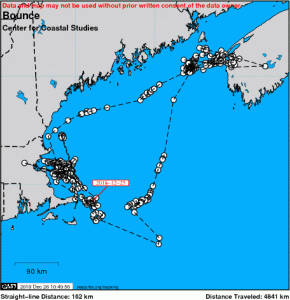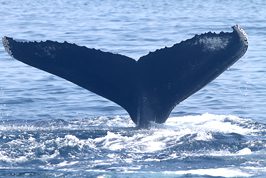Bounce
CCS has been working to better understand and improve satellite tagging as part of long-term research on Gulf of Maine humpback whales. Satellite-monitored radio tags have yielded important information for the conservation and management of large whales. However, it is not uncommon for tags to stop transmitting within days to months of deployment, and follow-up studies to assess important impacts on the whales had been limited. In 2011, we began a collaborative study to better understand the effectiveness of satellite tagging, its impacts on tagged individuals and humpback whale movement and humpback use in the Gulf of Maine. You can learn more about the study here.

Bounce spent Christmas Day, 2018 foraging east of Chatham, Massachusetts. Data visualization provided by seaturtle.org.
Bounce was one of 15 humpback whales tagged by a collaborating expert from NOAA’s Marine Mammal Laboratory in the summer of 2018. We have studied Bounce every year since her year of birth and have learned a tremendous amount about her life (and many others) based on photographed sightings alone. The tags have provided finer-scale data on her movements and habitat use than we had in the past, as well as insight on when and how to use this research tool.
Bounce ranged widely on the Gulf of Maine feeding ground after she was tagged in July 2018. She spent Christmas Day and New Year’s Day foraging east of Cape Cod and began her southbound migration to the Caribbean breeding grounds on January 9.

Ventral fluke of Bounce. CCS image collected under NOAA research permit 16325.
Bounce arrived at the humpback breeding range off the Dominican Republic on January 25, 2018 after a journey of almost 1,500 nautical miles. This is the first southbound humpback whale migration ever tracked in real time from the Gulf of Maine feeding ground.
After completely documenting her southbound migration, Bounce’s tag stopped transmitting on February 11, 2019 on Silver Bank. We do not know why her tag stopped, but it may have been dislodged during her activities on the breeding grounds. In June 2019, CCS re-sighted Bounce in good condition and having shed her tag. Bounce’s last movements added to our understanding of migration and how humpback whales use their breeding grounds.
Selected 2018 history:
June 17: CCS re-encountered Bounce in good condition in the Gulf of Maine.
February 11: Bounce’s tag stopped transmitting on Silver Bank.
February 6: Bounce arrived at Silver Bank.
February 5: Bounce appears to have moved outside of Samaná Bay, but is still off the northern coast of the Dominican Republic.
February 4: Bounce’s tag is still transmitting in the vicinity of Samaná Bay.
February 1: Bounce is in Samaná Bay.
January 30: After a couple of days of uncertainty, we have finally received a reliable location for Bounce. She is in Samaná Bay!
January 29: Bounce’s tag is still transmitting, but the locations received over the past two days have been very imprecise. The data still suggests that she is off the northern coast of the Dominican Republic, but we will update the map when her exact location can be better established.
January 27: Bounce’s transmissions have been less frequent since she arrived on the breeding range. Her latest location places her off the northeastern coast of the Dominican Republic.
January 25: Bounce has reached the breeding range, but is still traveling. She is currently east of Navidad Bank, northeast of Samaná Bay and northwest of Puerto Rico. It remains to be seen where she will stop first.
January 22: Bounce, the tagged humpback whale is now just a little over 300 nautical miles from breeding sites in the Caribbean!
January 16: Time has been flying by and Bounce has just passed Bermuda. She is now nearly halfway to the breeding grounds.
January 9: Bounce begins her migration south from the Gulf of Maine.

Our Work
Humpback Whale Research
Right Whale Research
Marine Animal Entanglement Response
Marine Geology Department
Water Quality Monitoring Program
Marine Fisheries Research
Seal Research
Shark Research
Marine Education
Interdisciplinary
Marine Debris and Plastics Program
Marine Policy Initiative
Cape Cod Climate Change Collaborative
Publications

